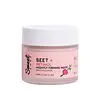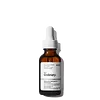What's inside
What's inside
 Key Ingredients
Key Ingredients

 Benefits
Benefits

 Concerns
Concerns

No concerns
 Ingredients Side-by-side
Ingredients Side-by-side

Water
Skin ConditioningButylene Glycol
HumectantGlycerin
HumectantHydrogenated Polydecene
EmollientCetearyl Olivate
1,2-Hexanediol
Skin ConditioningCetearyl Alcohol
EmollientCetyl Ethylhexanoate
EmollientSorbitan Olivate
EmulsifyingSynthetic Beeswax
Emulsion StabilisingBeta Vulgaris Root Extract
Skin ConditioningHydroxypinacolone Retinoate
Skin ConditioningHyaluronic Acid
HumectantHydrolyzed Hyaluronic Acid
HumectantSodium Hyaluronate
HumectantSqualane
EmollientCannabis Sativa Seed Oil
EmollientCamellia Japonica Flower Extract
EmollientLavandula Angustifolia Flower Extract
CleansingNelumbo Nucifera Flower Extract
Skin ConditioningTocopherol
AntioxidantPrunus Avium Fruit Extract
Skin ConditioningCoccinia Indica Fruit Extract
Skin ConditioningEclipta Prostrata Extract
Skin ConditioningFicus Carica Fruit Extract
HumectantApium Graveolens Extract
Skin ConditioningEthylhexylglycerin
Skin ConditioningGlyceryl Stearate
EmollientPropanediol
SolventCarbomer
Emulsion StabilisingTromethamine
BufferingCaprylic/Capric Triglyceride
MaskingDimethyl Isosorbide
SolventGlyceryl Glucoside
HumectantParfum 100%
MaskingWater, Butylene Glycol, Glycerin, Hydrogenated Polydecene, Cetearyl Olivate, 1,2-Hexanediol, Cetearyl Alcohol, Cetyl Ethylhexanoate, Sorbitan Olivate, Synthetic Beeswax, Beta Vulgaris Root Extract, Hydroxypinacolone Retinoate, Hyaluronic Acid, Hydrolyzed Hyaluronic Acid, Sodium Hyaluronate, Squalane, Cannabis Sativa Seed Oil, Camellia Japonica Flower Extract, Lavandula Angustifolia Flower Extract, Nelumbo Nucifera Flower Extract, Tocopherol, Prunus Avium Fruit Extract, Coccinia Indica Fruit Extract, Eclipta Prostrata Extract, Ficus Carica Fruit Extract, Apium Graveolens Extract, Ethylhexylglycerin, Glyceryl Stearate, Propanediol, Carbomer, Tromethamine, Caprylic/Capric Triglyceride, Dimethyl Isosorbide, Glyceryl Glucoside, Parfum 100%
 Reviews
Reviews

Ingredients Explained
These ingredients are found in both products.
Ingredients higher up in an ingredient list are typically present in a larger amount.
This ingredient is an emollient, solvent, and texture enhancer. It is considered a skin-softener by helping the skin prevent moisture loss.
It helps thicken a product's formula and makes it easier to spread by dissolving clumping compounds.
Caprylic Triglyceride is made by combining glycerin with coconut oil, forming a clear liquid.
While there is an assumption Caprylic Triglyceride can clog pores due to it being derived from coconut oil, there is no research supporting this.
Learn more about Caprylic/Capric TriglycerideDimethyl Isosorbide is a low-irritation solvent that helps deliver actives into your skin. It is created from glucose.
Research shows how well this ingredient works depends on the active and formulation rather than the concentration alone. This means adding more Dimethyl Isosorbide does not guarantee better penetration of ingredients into the skin.
This ingredient is a retinoid. It usually goes by a more common name: "Granactive".
Hydroxypinacolone Retinoate (HPR) belongs to the class of retinoids that also includes retinol and tretinoin.
Retinoids have been proven to:
So what is the difference between all the retinoids?
Most retinoids need to go through a conversion line to become effective on skin. The ending product is retinoic acid. Retinoic acid is AKA tretinoin.
HPR is an ester of tretinoin. Emerging studies suggest HPR to have an added benefit that other retinoids don't have: Low irritation.
A study from 2021 found HPR to have the greatest stability when exposed to light and temperature out of all the commercial retinoids.
A note about naming:
The name "Granactive" is the trade name and the name most commonly used on packages.
Granactive is the name of the mixture - about 90% solvent and 10% HPR. A product with 5% granactive has 0.5% HPR.
Learn more about Hydroxypinacolone RetinoateSqualane is an emollient that helps the skin hold onto moisture. It's an oily liquid that occurs naturally in certain types of fish and plant oils.
Because squalane boosts hydration in the skin, it also comes with plenty of benefits: it is an antioxidant and can help fight free radicals and skin damage. Squalane is also found to have a detoxifying effect when applied.
Squalane comes from squalene, which occurs naturally within the sebum of our skin. It is one of the oils our skin produces to keep itself hydrated. Squalane is the hydrogenated version of squalene and has a longer shelf life.
Research shows that squalane is non-irritating (even at 100% concentration).
In general, it's a fantastic ingredient. It does a great job at hydrating the skin, and it's suitable for those with sensitive skin.
The source of squalane may impact malassezia / fungal acne. This is because olive oil derived squalane can contain impurities such as fatty acids and plant waxes. Sugarcane derived squalane is recommended for anyone with malassezia concerns.
Is squalane vegan?
This depends on the source. Squalane can be derived from both plants and animals. Most squalane used in skincare comes from plants.
Please note: the source of squalane is only known if disclosed by the brand. We recommend reaching out to the brand if you have any questions about their squalane.
Read more about squalene with an "e".
Is squalane an oil?
Squalane is often called an oil, but it’s technically not; it’s a hydrocarbon, meaning it’s only made of carbon and hydrogen, unlike true oils which are triglycerides made of fatty acids and glycerol.
The term “oil-free” isn’t regulated, so companies can define it however they want. Some exclude all oils, while others just avoid mineral oil or comedogenic oils.
While some people avoid oils thinking they cause breakouts, the right kind of oil (or oil-like ingredient like squalane) can actually help balance and hydrate your skin. It’s worth testing out simple oils or squalane to see what works best for your skin.
Learn more about Squalane